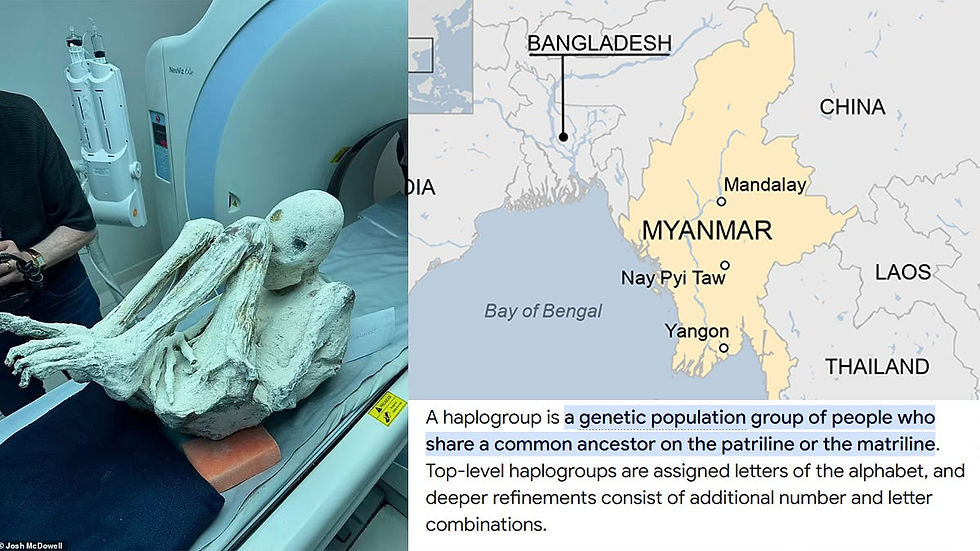Peruvian Forensic Doctor Shares Research on the Nazca Alien Bodies
- Cristina Gomez

- Jan 8
- 3 min read
Updated: Jul 28
In an extraordinary development that has sparked both scientific intrigue and controversy, researchers in Peru have been investigating a series of unusual bodies discovered in the Nazca region. At the forefront of this research is Dr. David Ruiz Vela, a forensic medicine expert with thirty years of medical experience. The following article explores Dr. Ruiz Vela’s extensive background, his detailed findings from examining these Nazca bodies, and the challenges faced by researchers as they attempt to understand these potentially groundbreaking discoveries that feature unique anatomical characteristics including tridactyl features and preserved internal organs.
Dr. David Ruiz Vela brings three decades of medical expertise to the investigation of the controversial Nazca bodies. As a distinguished professional with specialties in both plastic surgery and forensic medicine, he serves as president of the Peruvian Society of Legal Medicine and holds membership in the New York Academy of Sciences. By chance, his involvement in the Nazca bodies research began after being asked to observe tomographic scans on Peruvian television, where his expertise in analyzing medical imagery led him to conclude the scans showed genuine anatomical structures rather than fabrications.

The Findings
Upon detailed examination of the Nazca specimens, Dr. Ruiz Vela documented several extraordinary anatomical features through advanced medical imaging. Using high-resolution tomography with remarkably precise 0.5mm interval scans, the research revealed bodies with distinct tridactyl characteristics — three-fingered hands and feet — alongside complete internal organ preservation. This preservation state stands in stark contrast to Egyptian mummies, where organs were typically removed during the mummification process. The specimens’ vascular systems remained notably intact, with blood vessels clearly visible through tomographic imaging (in the case of Montserrat). This preservation was achieved through burial in diatomaceous earth, a silica-based material that facilitated natural desiccation while maintaining the bodies’ structural integrity, allowing for detailed internal examination without destructive investigation methods.

Among the most significant specimens studied was one nicknamed “Montserrat,” which appeared to contain a pregnant tridactyl, presenting a unique opportunity to study potential reproductive characteristics. The tomographic scans revealed blood vessels extending from a placental base into egg-like structures, suggesting an ovoviviparous reproductive system with mammotropic features.

Another category of specimens included the “tiny bodies,” measuring between 40–60 centimeters in length. These specimens showed various developmental stages from juvenile to adult, indicating potential life cycle variations.
The Pushback
The research faced significant opposition from Peru’s institutional bodies. The Ministry of Culture’s approach led to legal complications rather than scientific investigation, while the Public Ministry’s examination focused solely on artisan-crafted replicas confiscated at airports rather than the actual specimens held by universities. This created a problematic narrative where findings based on examining crafted replicas were generalized to dismiss all specimens, including those that had undergone rigorous scientific examination.

Dr. Ruiz Vela notes that this institutional resistance stems largely from procedural missteps and a lack of appropriate technological capabilities within Peru’s public institutions, rather than malicious intent. The public ministry notably lacks modern imaging equipment, including functional electron microscopes and tomography machines, significantly limiting their ability to conduct thorough scientific analysis of such specimens.

The research has encountered several obstacles, including limited technological capabilities in Peru’s public institutions and a lack of local expertise in paleo DNA analysis. Critics have often made assessments without direct examination of the specimens, leading to controversy within the scientific community. Despite these challenges, Dr. Ruiz Vela emphasizes the potentially disruptive nature of these discoveries, noting that while tridactyl representations exist in ancient artifacts worldwide, these bodies represent the first physical specimens of their kind.

The investigation continues to evolve, with plans for additional studies including DNA analysis, carbon-14 dating, and higher-resolution imaging at facilities with advanced technology. Dr. Ruiz Vela and his team maintain that these findings could significantly impact our understanding of ancient history, suggesting that conventional historical narratives may be incomplete. The research team advocates for international scientific collaboration to conduct comprehensive analysis of these unique specimens.
Read part 1 here.














Comments